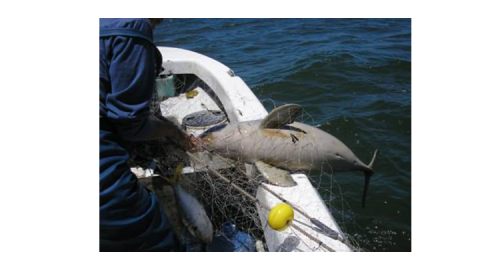
California seeks to implement more restrictions on gillnet fishing in its State and adjacent Federal waters. See: https://www.seafoodsource.com/california-bill-would-further-limit-gilln….
If you follow what is happening globally with gillnets, which some people call "curtains of death," this new but not original call for a ban using them off California is noteworthy.
Why would CA consider such a ban? In general, gillnets are not popular with many Californians who decry their widespread killing of ocean animals. This new bill comes following two already implemented regulations restricting gillnet fishing in CA:
- Under the Marine Resources Prot ection Act of 1990, gillnets and trammel nets are prohibited within 3nm from the mainland; the shorter of 1 nm or 70 fm depth from the Channel Islands; and "In waters less than 35 fm between a line true from Point Fermin and a line running 270 degrees true from the south jetty of Newport" (2010 CA Fish and Game Code, Article 1.4 .4.).
- According to CA Fish and Game Code 8576, no drift nets in the shark and swordfish are permitted between February 1 and April 30 inclusive in less than 200 m from shore; and within 75 nm from mainland between May 1 and August 14 [http://www.nmfs.noaa.gov/pr/pdfs/fisheries/lof2012/ca_thresher_shark_sw…].
- Finally, there is pending legislation (the federal Driftnet Modernization and Bycatch Reduction Act) which is set to end more larger scale gillnets in 2027.
Within the U.S. it is not only CA that has implemented gillnet bans. Many other States have them in place including:
- Florida, where under Article X, Section 16 of the Constitution of Florida bans gill nets, trammel nets, and other entangling nets state-wide within three “miles” of the coast. However, in this case the justification for this ban appears to have had more to do with depleting fishstocks and avoiding conflicts between recreational and commercial fishermen than it did with concerns about marine mammals or other non-target species (Anderson, D.K. 2002. Understanding the impact of the Florida net ban (Article X, Section 16 of the State Constitution). Proceedings of the Gulf and Caribbean Fisheries Institute 53: 378-392.)
- Texas, where giillnets are not “legal gear” in Texas (M. Fisher, pers. comm.). However, it remains uncertain if the legislation supporting this determination may havebeen repealed (see http://www.statutes.legis.state.tx.us/Docs/PW/htm/PW.66.htm).
- Washington, where The Puget Sound Region Salmon Drift Gillnet Fishery has state-managed area closures; marine mammals reported to interact with this fishery are Dall’s porpoise, Harbor porpoise, and Harbor seal (http://www.nmfs.noaa.gov/pr/pdfs/fisheries/lof2012/wa_pugetsound_region…).
- The State of Alaska mandates several area closures of drift and set nets in its waters (NMFS 2017 List of Fisheries), some of which may be justified wholly or in part by concern over marine mammal bycatch. Species observed as bycatch in these gears include beluga whale (Delphinapterus leucas), gray whale, humpback whale, harbor porpoise, Dall’s porpoise, Pacific white-sided dolphin harbor seal, northern fur seal (Callorhinus ursinus), spotted seal (Phoca largha), Stellar sea lion (Eumetopias jubatus), and sea otter (Enhydra lutris).
- Hawaii, where Administrative Rule 13-75 prohibits the use of drift gillnets and other types of nets, and a number of closed areas were designated for “lay” andother gillnets surrounding Oahu, Hawaii, Kauai, Maui, and other islands (Hawaii Division of Aquatic Resources webpage [accessed on July 12, 2013](http://hawaii.gov/dlnr/dar/regulated_areas.html).
Featured Bycatch Species

Bycatch of pilot whales (short-finned) occurs in the pelagic longline fisheries targeting swordfish, tuna, and shark in the U.S.
